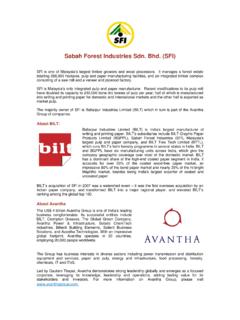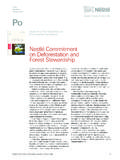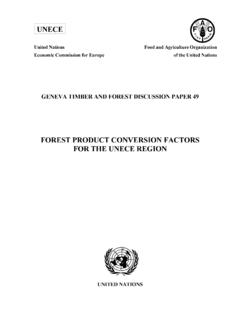Transcription of .¡P NON-WOOD FOREST PRODUCTS 18
1 I^ 7.. P. NON-WOOD FOREST PRODUCTS . NON-WOOD FOREST PRODUCTS . 18. World bamboo bamboo resources Athematic A thematic study study prepared prepared in the framework of the Global FOREST FOREST Resources Resources Assessment 2005. Assessment ~~. INBAR. 1. NON-WOOD FOREST PRODUCTS . \ ON-WOOD FOREST PRODUCTS . 18. World bamboo resources A. A thematic study study prepared prepared in the framework of the Global FOREST FOREST Resources Resources Assessment 2005. Assessment by Maxim Lobovikov Maxim Shyam Paudel Marco Piazza Piazza Hong Ren Ren Junqi Junqi Wu Wu FOOD AND. AND AGRICULTURE. AGRICULTURE ORGANIZATION. ORGANIZATION OF. OF THE. THE UNITED. UNITED NATIONS. NATIONS. Rome, Rome , 2007.
2 2007. The designations employed and the presentation of material in this information product do not imply the expression of any opinion whatsoever on the part of the Food and Agriculture Organization of the United Nations concerning the legal or development status of any country, territory, city or area or of its authorities, or concerning the delimitation of its frontiers or boundaries. All rights reserved. Reproduction and dissemination of material in this information product for educational or other non-commercial purposes are authorized without any prior written permission form the copyright holders provided the source is fully acknowledged. Reproduction of material in this information product for resale or other commercial purposes is prohibited without written permission of the copyright holder.
3 Applications for such permission should be addressed to: Chief Electronic Publishing Policy and Support Branch Information Division FAO. Viale delle Terme di Caracalla, 00153 Rome, Italy or by email to: FAO 2007. Contents Acknowledgements .. v vii Acronyms and ix Executive summary .. xi 1. 1. Bamboo as a plant .. 1. Bamboo as a resource .. 1. Previous studies on bamboo resources .. 2. Application of remote sensing to bamboo resources assessment .. 4. The present 6. The 6. Information 7. 2. Extent and characteristics of bamboo resources .. 11. Extent of bamboo resources .. 11. Ownership of bamboo 18. Characteristics of bamboo resources .. 21. Growing stock of bamboo resources.
4 23. Bamboo biomass .. 26. Diversity of bamboo tree 28. Bamboo health and vitality .. 29. 3. Bamboo PRODUCTS and trade .. 31. Bamboo product 31. Bamboo removals .. 33. Bamboo trade .. 36. 4. Conclusions and recommendations .. 39. 43. Annex 1: Global bamboo resources assessment: tables and definitions .. 47. Annex 2: Contributors .. 49. Annex 3: Bamboo classes in national FOREST classifications .. 51. Annex 4: Extent of bamboo FOREST by type .. 55. iii Annex 5: Current and newly introduced Harmonized System codes for bamboo and rattan 57. Annex 6: Country 59. Tables 1 Extent of bamboo FOREST area as reported by previous 3. 2 Sources of information and validation for the 8.
5 3 Summary of information provided in country reports ..9. 4 Extent of bamboo FOREST in Asia, Africa and Latin America .. 12. 5 Ownership of bamboo in Asia and Africa .. 19. 6 Characteristics of bamboo resources in Asia .. 22. 7 Growing stock of bamboo 24. 8 Bamboo biomass stock in some Asian countries .. 27. 9 Diversity of bamboo 29. 10 Bamboo removals, bamboo PRODUCTS and their value .. 34. 11 Export of bamboo PRODUCTS in 2000 .. 37. 12 Main importers of bamboo PRODUCTS in 37. 13 Bamboo export value in China 1998 37. Figures 1 Countries participating in the FAO/INBAR bamboo thematic study .. 7. 2 Contribution of world bamboo resources by 11. 3 Countries with the largest bamboo 14.
6 4 Composition of bamboo types by continents 14. 5 Trends in ownership of bamboo in Asia and Africa 1990 20. 6 Areas of natural and planted bamboo in Asia .. 22. Boxes 1 INBAR and FAO activities related to bamboo .. 2. 2 Pilot studies .. 5. 3 Animal species associated with 27. iv Acknowledgements This study is a product of an FAO/INBAR initiative involving member countries of both organizations, donors, agencies, institutions, organizations and individuals. More than 100 individuals, representing 30 national and international organizations and agencies, contributed directly to the report. The authors are particularly grateful to the United Nations Environment Programme and the United States Geological Survey for their support, assistance, training and help to team members during the study and the drafting of the report.
7 National FOREST inventory departments in China, India and Indonesia provided crucial contributions to the design of the study and the testing and finalization of the reporting format and guidelines. Participants of four joint FAO/INBAR workshops and meetings in 2004 2005 discussed, supported and further developed the study. Twenty-five FAO and INBAR. member states submitted country reports. National correspondents to FAO's Global FOREST Resources Assessment 2005 and their teams, together with experts from participating countries, collected and validated data and provided the best available knowledge on the subject. Editing and production of the report were carried out by Lynn Ball, Mar a Guardia and Laura Russo.
8 FAO and INBAR are grateful to all the countries, organizations and individuals that provided their excellent contributions to this study. v Foreword Bamboo is a major NON-WOOD FOREST product and wood substitute. It is found in all regions of the world and plays an important economic and cultural role. Used for housing, crafts, pulp, paper, panels, boards, veneer, flooring, roofing, fabrics, oil, gas and charcoal (for fuel and as an excellent natural absorbent), it is also a healthy vegetable (the bamboo shoot). Bamboo industries are now thriving in Asia and are quickly spreading across the continents to Africa and America. In spite of bamboo's importance worldwide, global statistics on its resources, production and trade remain rather scarce and inconsistent.
9 Lack of reliable, comprehensive data on bamboo resources and utilization hampers their sustainable development and limits their potential to contribute to poverty reduction. In the past, both FAO and INBAR, under their respective mandates, have addressed the issue of bamboo resources assessment through various activities and studies. The present thematic study on bamboo was developed by FAO and INBAR jointly in the framework of FAO's Global FOREST Resources Assessment 2005 (FRA 2005), with the aim of filling the gap in global information and providing a first, comprehensive assessment of the world's bamboo resources. The study was officially launched during a joint FAO/INBAR workshop in Thailand in November 2004, preceded by much preparatory work, regional consultations and pilot testing.
10 The study is thus the result of a three-year process of data collection and validation, involving many partners from participating countries and international organizations, in line with the FRA 2005 philosophy of global partnership. It is hoped that the information and knowledge generated by this study will be used by national policy processes and that, conversely, feedback from users will serve to improve future global resources assessments. (. Maxim Lobovikov Director of the FAO/INBAR Bamboo Wulf Killmann Thematic Study Director INBAR Programme Director FOREST PRODUCTS and Industries Division FAO Forestry Department vii Acronyms and abbreviations ABS American Bamboo Society DNA Deoxyribonucleic acid FRA Global FOREST Resources Assessment HS Harmonized System (WCO).)














